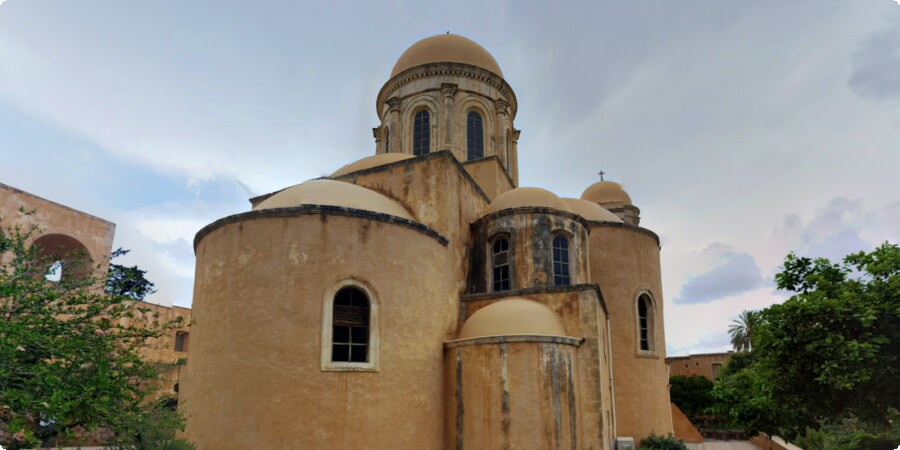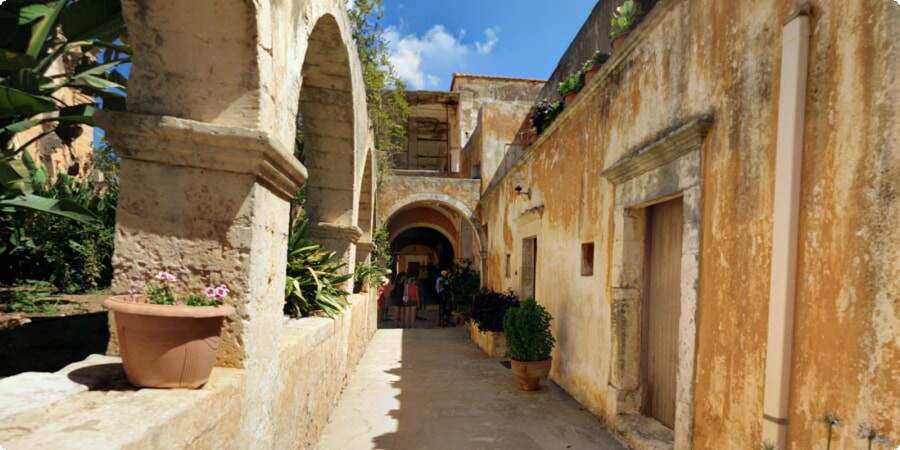Agia Triada Monastery: A Guide to Chania’s Spiritual Oasis
Nestled in the tranquil countryside of the Akrotiri Peninsula in Chania, Crete, Agia Triada Monastery, also known as the Monastery of the Holy Trinity, stands as a beacon of serenity and spiritual refuge. This historic monastery, with its stunning architecture and lush surroundings, offers visitors a unique blend of religious significance and natural beauty. Known for its olive oil and wine production, Agia Triada Monastery is not just a place of worship but also a thriving agricultural center, making it a must-visit destination for those seeking peace and a deeper connection with Crete's rich heritage.
Historical Background
The Agia Triada Monastery has a storied past that dates back to the early 17th century. Founded by the Venetian brothers Jeremiah and Laurentius Giagarolo, the monastery's construction began in 1612. The brothers, originally from a noble Venetian family, embraced Orthodox Christianity and sought to establish a religious site that combined both their architectural prowess and spiritual devotion.
The monastery faced numerous challenges throughout its history, including invasions and periods of decline, but it remained a resilient symbol of faith and perseverance. During the Greek War of Independence in the 19th century, the monastery played a significant role as a center of resistance and refuge, further cementing its place in the annals of Cretan history.
Today, Agia Triada stands as a testament to the enduring spirit of the island's people and their dedication to preserving their cultural and religious heritage. Its architectural style reflects a blend of Renaissance and Cretan influences, making it an exceptional example of monastic architecture in Greece.

Architectural Features
The architectural beauty of Agia Triada Monastery is immediately apparent upon arrival. The monastery complex is a harmonious blend of Renaissance and Orthodox architectural styles, creating a visually stunning and spiritually uplifting environment.
-
The Main Church (Katholikon): The centerpiece of the monastery is the Katholikon, dedicated to the Holy Trinity. This grand church features a domed basilica design, with intricate frescoes and iconography adorning its interior. The frescoes, created by renowned artists of the time, depict scenes from the Bible and the lives of saints, offering a glimpse into the rich religious traditions of the Orthodox Church.
-
Cloisters and Courtyards: Surrounding the Katholikon are the cloisters and beautifully landscaped courtyards. These areas provide a peaceful retreat where visitors can reflect and enjoy the serene surroundings. The courtyards are often filled with aromatic herbs and flowers, adding to the tranquil atmosphere.
-
Library and Museum: The monastery houses a library with a collection of rare manuscripts and religious texts, showcasing the intellectual pursuits of the monks. Additionally, a small museum displays ecclesiastical artifacts, including vestments, icons, and ceremonial objects, offering insights into the religious practices and history of the monastery.
Exploring the architectural marvels of Agia Triada Monastery provides a deeper understanding of the cultural and spiritual significance of this sacred site. For those planning a visit, renting a car can greatly enhance the experience by providing the freedom to explore the surrounding areas at your own pace. Consider booking a car through Cars Scanner to make your journey to Agia Triada and other Cretan attractions seamless and enjoyable.

Spiritual Significance
Agia Triada Monastery is not just an architectural marvel but also a living, breathing center of spiritual activity. For centuries, it has been a place of prayer, contemplation, and monastic life. The monastery is home to a small community of monks who dedicate their lives to spiritual pursuits and the preservation of the monastery's traditions.
-
Monastic Life: The monks at Agia Triada follow a daily routine of prayer, meditation, and work. Their lives are marked by simplicity and devotion, reflecting the core values of the Orthodox Christian faith. Visitors can often witness the monks engaging in their daily rituals, providing a unique glimpse into monastic life.
-
Religious Services: The monastery conducts regular religious services, including the Divine Liturgy, Vespers, and other important Orthodox Christian rites. These services are open to the public, offering visitors the opportunity to participate in or observe the profound spiritual practices that have been maintained here for centuries.
-
Pilgrimage Site: Agia Triada is a significant pilgrimage site for Orthodox Christians. Many faithful come here seeking spiritual solace, healing, and a deeper connection with their faith. The monastery's serene environment and the palpable sense of history and devotion make it an ideal place for reflection and spiritual renewal.
Visiting the Monastery
Visiting Agia Triada Monastery is a journey into the heart of Crete's spiritual and cultural heritage. Here are some practical tips to help you make the most of your visit:

-
Opening Hours and Admission: The monastery is generally open to visitors from morning until late afternoon. It's advisable to check the specific opening hours before your visit, as they can vary depending on the season and religious events. A small admission fee is typically required, which helps support the maintenance and activities of the monastery.
-
Guided Tours: For a more enriching experience, consider joining a guided tour. Knowledgeable guides can provide in-depth information about the history, architecture, and spiritual significance of Agia Triada. Tours are often available in multiple languages to accommodate international visitors.
-
Dress Code: As a place of worship, visitors are expected to dress modestly. This means no shorts, sleeveless tops, or revealing clothing. Scarves and wraps are usually provided at the entrance for those who need them. Respectful attire ensures that the sanctity of the site is maintained for all visitors and worshippers.
-
Photography: While photography is allowed in many parts of the monastery, be mindful of signs indicating areas where it is prohibited, especially during religious services. It's important to respect the privacy and spiritual practices of the monks and other visitors.
For those planning to explore the monastery and other parts of Crete, renting a car offers the flexibility to travel at your own pace. Consider booking a car through Cars Scanner to ensure a convenient and comfortable journey across the island.
Gardens and Surroundings
The gardens and natural surroundings of Agia Triada Monastery are as captivating as its spiritual and architectural aspects. The monastery is set amidst lush greenery, with well-tended gardens that enhance its serene atmosphere.
-
Monastery Gardens: The gardens within the monastery grounds are meticulously maintained, featuring a variety of aromatic herbs, flowers, and fruit trees. These gardens not only add to the beauty of the monastery but also serve practical purposes, providing ingredients for the monks' daily needs and for the production of their renowned olive oil and wine.
-
Olive Groves and Vineyards: Surrounding the monastery are extensive olive groves and vineyards, which have been cultivated by the monks for centuries. Visitors can often see the monks at work, harvesting olives and grapes using traditional methods. The monastery's olive oil and wine are famous throughout Crete and are available for purchase, offering a taste of the monastery's heritage.
-
Scenic Walks: The Akrotiri Peninsula, where Agia Triada is located, offers numerous walking trails that lead through scenic landscapes of rolling hills, rocky outcrops, and coastal vistas. These trails provide an opportunity to explore the natural beauty of the area while enjoying the peace and tranquility that the monastery's setting affords.
Exploring the gardens and surroundings of Agia Triada Monastery allows visitors to connect with nature and appreciate the harmonious blend of spiritual and environmental stewardship that defines this sacred site.

Best Times to Visit
Visiting Agia Triada Monastery can be a rewarding experience any time of year, but certain seasons offer unique advantages:
-
Spring (April to June): Spring is one of the best times to visit Agia Triada. The weather is mild, the gardens are in full bloom, and the surrounding countryside is lush and green. This season is perfect for exploring the monastery grounds and enjoying the scenic walks around the Akrotiri Peninsula.
-
Summer (July to August): Summer is the peak tourist season in Crete. While the weather is hot, the monastery's cool, shaded areas provide a pleasant respite from the heat. Early morning or late afternoon visits are recommended to avoid the midday sun and large crowds.
-
Autumn (September to October): Autumn offers a quieter, more relaxed atmosphere. The weather is still warm, and the crowds have thinned out. This is an ideal time for those who prefer a more peaceful visit, with plenty of opportunities to engage in reflection and contemplation.
-
Winter (November to March): Winter is the off-season in Crete, characterized by cooler temperatures and fewer tourists. While the monastery may have shorter visiting hours, the serene and quiet environment can provide a deeply personal and intimate experience.
Nearby Attractions
Agia Triada Monastery is located in an area rich with historical and natural attractions. Here are a few nearby sites worth exploring:
-
Gouverneto Monastery: Just a short drive from Agia Triada, Gouverneto Monastery is one of the oldest monasteries in Crete. Known as the "Monastery of the Angels," it features impressive architecture and a serene environment ideal for spiritual reflection.
-
Seitan Limania Beach: For a change of scenery, visit the stunning Seitan Limania Beach. Nestled between steep cliffs, this secluded beach boasts crystal-clear waters and dramatic landscapes. It's a great spot for swimming and relaxation after exploring the monasteries.
-
Venizelos Graves: Located on a hill overlooking Chania, the Venizelos Graves offer panoramic views of the city and the sea. This historic site is the final resting place of Eleftherios Venizelos, one of Greece's most prominent political figures.
For travelers looking to explore these attractions and more, consider booking a car through Cars Scanner to ensure convenient and flexible transportation around the region.
Local Cuisine and Dining
A visit to Agia Triada Monastery wouldn't be complete without indulging in some of Crete's delicious local cuisine. Here are a few dining recommendations near the monastery:
-
Traditional Tavernas: The area around the monastery is dotted with traditional tavernas where you can savor authentic Cretan dishes. Try specialties like dakos (rusk with tomato and cheese), kalitsounia (cheese or herb pies), and freshly grilled seafood.
-
Monastery Products: Don’t miss the chance to sample and purchase the monastery's own products, including olive oil, wine, and honey. These items are produced using traditional methods and reflect the monastic dedication to quality and sustainability.
-
Local Markets: Visit nearby markets in Chania to experience the vibrant food culture of Crete. Here, you can find a variety of local produce, cheeses, olives, and baked goods. The central market in Chania is a great place to start and offers a wide selection of Cretan delicacies.
Visiting Agia Triada Monastery is more than just a trip to a historical site; it's an immersive experience that combines spirituality, history, and natural beauty. Whether you're exploring its architectural splendor, participating in its spiritual rituals, or enjoying the peaceful gardens and surroundings, Agia Triada offers a unique glimpse into the heart of Crete. Plan your visit carefully to make the most of this sacred oasis, and be sure to explore the rich cultural and natural attractions that the region has to offer.